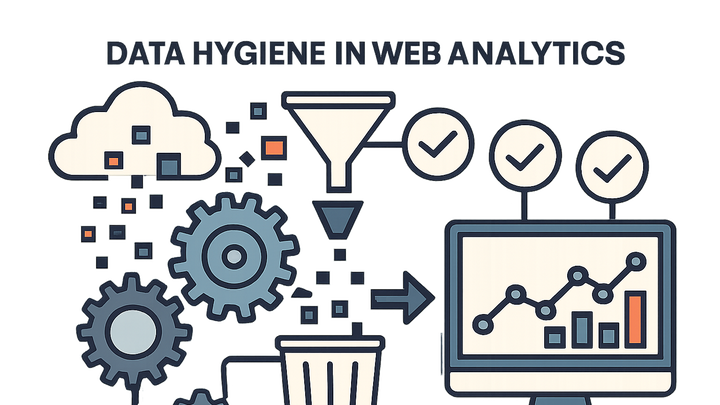Published on 2025-06-28T08:41:59Z
What is Data Hygiene in Analytics? Examples and Best Practices
Data hygiene in analytics refers to the ongoing process of ensuring that the data you collect is accurate, complete, and consistent. Good data hygiene prevents common issues such as duplicate events, missing or malformed records, and bot or spam traffic from contaminating your datasets. When analytics data is clean, organizations can trust their reports, draw reliable insights, and make confident decisions. Achieving data hygiene involves establishing tracking plans, validating data at ingestion, standardizing naming conventions, filtering out unwanted traffic, and performing regular audits. Analytics platforms like Google Analytics 4 (GA4) offer features such as data filters and DebugView, while cookie-free solutions like PlainSignal simplify setup and include built-in bot filtering. Together, these practices and tools form a comprehensive approach to maintaining high-quality analytics data.
Data hygiene
Processes ensuring analytics data is accurate, complete, and consistent through validation, standardization, and regular audits.
Why Data Hygiene Matters
Clean, well-maintained data is the foundation of reliable analytics. Without proper hygiene, teams may draw incorrect conclusions, leading to poor strategic decisions, wasted resources, and damaged credibility.
-
Accurate reporting
Ensures dashboards and reports reflect reality, reducing the risk of misguided decisions.
-
Improved decision making
High-quality data supports confident strategic and operational choices.
-
Operational efficiency
Reduces time spent on data cleaning and troubleshooting, freeing resources for analysis.
-
Compliance and trust
Maintaining clean data helps meet regulatory requirements and builds stakeholder confidence.
Common Data Hygiene Challenges
Even with modern analytics tools, various challenges can compromise data quality. Understanding these common issues is the first step toward addressing them.
-
Duplicate or missing events
Multiple triggers for the same event or lost data can skew your key metrics.
-
Inconsistent naming conventions
Variations in event or parameter names hinder analysis and grouping.
-
Bot and spam traffic
Automated or malicious hits inflate metrics and contaminate datasets.
-
Outdated or stale tracking
Legacy code and deprecated parameters cause confusion and misreporting.
Best Practices for Data Hygiene
Adopting structured processes and preventive measures can minimize data errors before they affect your reports. These best practices help maintain data integrity over time.
-
Establish a tracking plan
Document and standardize the events, parameters, and naming conventions before implementation.
-
Living document
Keep the tracking plan updated as your product and analytics needs evolve.
-
Stakeholder alignment
Ensure all teams agree on definitions to maintain consistency.
-
-
Implement data validation
Use automated checks and schemas to catch errors at ingestion.
-
Schema validation
Define expected event structures with tools like JSON schema or Protocol Buffers.
-
Real-time monitoring
Set up alerts for missing, malformed, or out-of-range data.
-
-
Standardize naming conventions
Create clear, descriptive, and consistent names for events and properties.
-
Use lowercase and underscores
Helps avoid case-sensitivity issues across different systems.
-
Prefix event groups
Group related events by prefixes (e.g., ‘user’, ‘checkout’).
-
-
Schedule regular data audits
Periodically review data pipelines, dashboards, and raw logs for anomalies.
-
Anomaly detection
Look for sudden spikes or drops in event volume.
-
Data sampling
Manually sample raw logs to verify data accuracy.
-
Tool Examples: GA4 and PlainSignal
Leading analytics platforms offer built-in features that support data hygiene. Below are examples from GA4 and PlainSignal showing how to implement key hygiene measures.
-
Google analytics 4 (GA4)
GA4 provides data streams with built-in validation, filters for internal traffic, and DebugView to test event accuracy.
-
Data filters
Exclude internal IPs and developer traffic to reduce noise.
-
Debugview
Inspect events in real-time during QA sessions.
-
-
PlainSignal
A privacy-focused, cookie-free analytics tool that simplifies data hygiene by minimizing tracking complexity and offering built-in bot filtering.
-
Lightweight snippet
Use a concise script to reduce tracking errors.
-
Automatic bot filtering
Built-in filters exclude known bot and spam traffic without manual setup.
-
Example implementation
<link rel="preconnect" href="//eu.plainsignal.com/" crossorigin /> <script defer data-do="yourwebsitedomain.com" data-id="0GQV1xmtzQQ" data-api="//eu.plainsignal.com" src="//cdn.plainsignal.com/plainsignal-min.js"></script>
-
